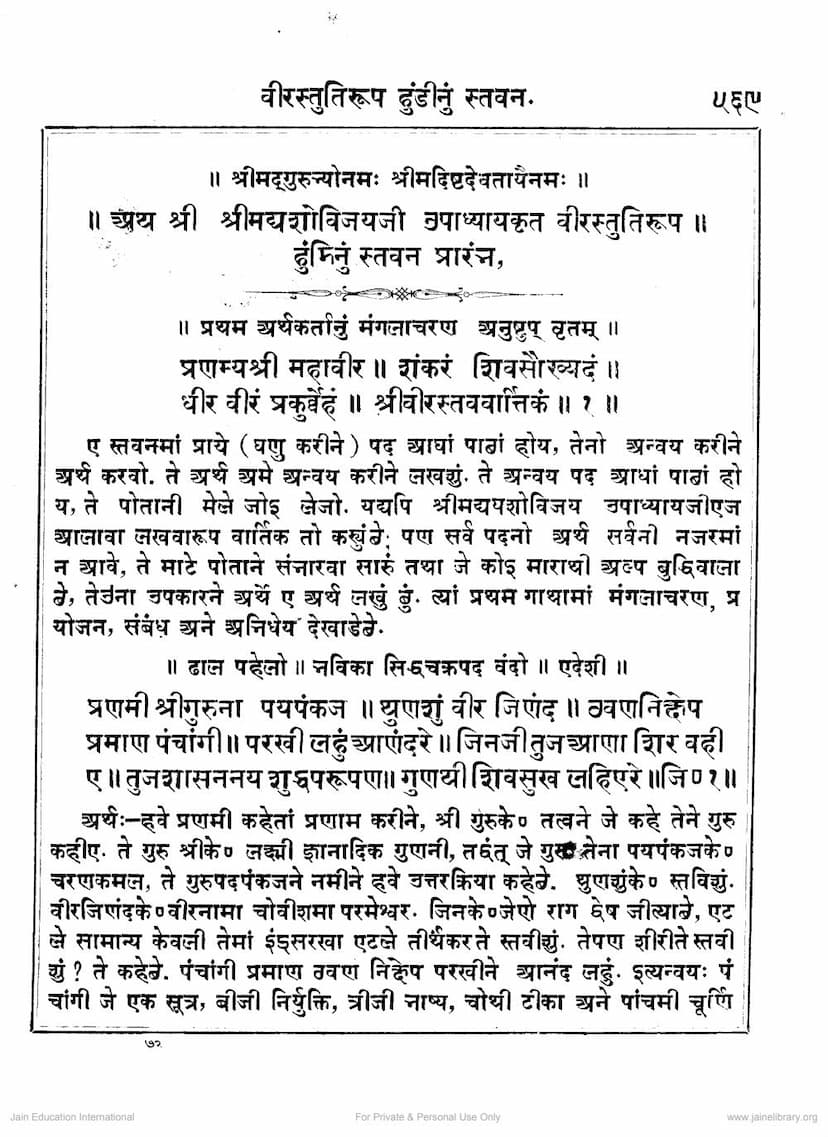Prakarana Ratnakar Part 3
Added to library: September 2, 2025

Summary
Based on the provided text, here's a comprehensive summary in English of the Jain text, focusing on the content of the "Prakarana Ratnakar Part 3," specifically the section containing the "Virastuti-rup Dundinuṁ Stavana" and related texts.
Overall Context:
This document appears to be a collection of Jain devotional texts and commentaries, compiled or published by Shravak Bhimsinh Manek from Mumbai. The primary focus of the provided pages is the "Virastuti-rup Dundinuṁ Stavana," a hymn or devotional poem in praise of Lord Mahavir, which also serves as a refutation of the "Dhundia" sect's beliefs and practices. The text delves into various aspects of Jain philosophy, particularly concerning nishchaya (ultimate reality) and vyavahar (conventional reality) naya, the concept of nishkramana (renunciation), and the validity of various devotional practices.
Key Themes and Content:
-
Praise of Lord Mahavir (Virastuti): The text begins with verses (shlokas) of praise for Lord Mahavir, highlighting his virtues and his victory over passions.
-
Refutation of the Dhundia Sect: A significant portion of the text is dedicated to addressing and refuting the views of the "Dhundia" sect, often referred to as misguided or heretical. The author aims to demonstrate the correctness of mainstream Jain principles by referencing scriptural authority.
-
Naya (Perspectives) and Nishkramana:
- The text heavily emphasizes the importance of understanding and applying the correct naya (perspectives) in interpreting Jain teachings. It argues that by adhering to the proper naya, one can avoid misunderstandings and contradictions.
- The concept of Nishkramana (renunciation) is discussed, particularly in relation to the celestial beings (devas) and their movements, as described in scriptural texts like the Bhagavati Sutra. The author uses these descriptions to illustrate the practices of enlightened beings and contrast them with the Dhundia views.
-
The Four Naya (Perspectives) and Six Naya: The text expounds on the significance of the four naya (Dravya, Kriya, Bhav, Kirtana) and the broader concept of six naya. It argues that understanding these naya is crucial for grasping the true meaning of the scriptures.
-
The Validity of Statue Worship (Pratima Puja): A central debate addressed is the validity of worshipping images (pratimas) of the Tirthankaras. The author defends this practice by referencing scriptural support, including the Bhagavati Sutra and Samavayanga Sutra, which describe celestial beings worshipping images. The Dhundias are presented as denying the significance of such practices.
-
The Meaning of "Chaitra": The text clarifies the meaning of "Chaitra," asserting that it refers to the Jina's abode or image, and refuting the Dhundia interpretation that it refers to knowledge (Jnana).
-
The Role of Actions and Devotion: The text highlights that both external actions (pratima puja, chanting, etc.) and internal devotion (bhava) are important. It discusses how actions performed with the right intention and understanding lead to merit, while those performed without proper understanding or with wrong intentions can be detrimental.
-
Scriptural Authority and Interpretation: The author repeatedly stresses the importance of scriptural evidence (Agama Pramana) to support their arguments. They meticulously quote verses from various Jain scriptures like Bhagavati Sutra, Uttaradhyayana Sutra, Dasavaikalika Sutra, Nandi Sutra, Anuyoga Dwara, Samavayanga Sutra, and Rachprashni Sutra to validate their points and refute the Dhundias.
-
The Importance of Guru and Tradition: The text implies the significance of following the teachings of a guru and the established tradition (parampara) in understanding Jain scriptures correctly.
-
Refuting Misconceptions: The author patiently addresses and refutes the specific misconceptions attributed to the Dhundia sect, such as their denial of certain scriptural accounts, their interpretation of key terms, and their approach to spiritual practices.
-
Detailed Scriptural Exegesis: The text provides detailed explanations and interpretations of various scriptural verses, discussing their contexts, etymology, and philosophical implications. This includes discussions on the nine-fold naya, the significance of different types of knowledge, and the conduct of ascetics.
-
The Nature of Liberation (Moksha) and Spiritual Path: While defending the practices, the text also implicitly points towards the ultimate goal of liberation (Moksha), which is attained through right faith (Samyaktva), right knowledge (Samyak Jnana), and right conduct (Samyak Charitra).
Specific Examples and Arguments:
- Dhundia Practices: The text criticizes the Dhundias for their incorrect interpretations and practices, such as denying the significance of idol worship or misinterpreting scriptural passages related to celestial beings and their actions.
- Naya: The author meticulously explains how the correct application of naya is crucial to reconcile apparent contradictions in scriptures, especially when dealing with descriptions of nishkramana and the nature of reality.
- Four and Six Naya: The text elaborates on the significance of the four naya (Dravya, Kriya, Bhava, Kirtana) and the broader six naya as foundational principles for understanding Jain doctrine.
- Janghacharana and Vidyacharana: Scriptural accounts of celestial ascetics like Janghacharana and Vidyacharana are cited to illustrate the extraordinary powers and the systematic, scripturally ordained paths of spiritual pursuit.
- The Role of Rituals: The text defends ritualistic practices like statue worship, explaining that their efficacy lies not just in the external act but in the inner devotion and intention.
- Ethical Conduct: The text emphasizes the importance of ethical conduct, righteousness, and the cultivation of virtues like renunciation, compassion, and detachment from worldly pleasures.
Overall Purpose:
The primary purpose of this text is to uphold and explain the orthodox Jain path, particularly as practiced by the author's tradition, by systematically refuting the views of the Dhundia sect. It aims to educate and guide readers towards a deeper and more accurate understanding of Jain principles through scriptural evidence and reasoned arguments. The text demonstrates a deep knowledge of Jain scriptures and their interpretations, presenting a robust defense of traditional practices.